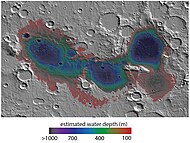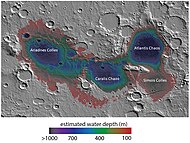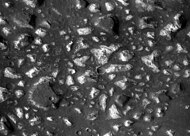Eridania Lake is a hypothesized ancient lake on Mars with a surface area of roughly 1.1 million square kilometers. It is located at the source of the Ma'adim Vallis outflow channel and extends into Eridania quadrangle and the Phaethontis quadrangle.[1] As Eridania Lake dried out in the late Noachian epoch it divided into a series of smaller lakes.[2][3][4][5]
-
Map showing estimated water depth in different parts of Eridania Sea This map is about 850 km (530 miles) across.
-
Features around Eridania Sea labeled
Later research with CRISM found thick deposits, greater than 400 meters thick, that contained the minerals saponite, talc-saponite, Fe-rich mica (for example, glauconite-nontronite), Fe- and Mg-serpentine, Mg-Fe-Ca-carbonate and probable Fe-sulphide. The Fe-sulphide probably formed in deep water from water heated by volcanoes. Such a process, classified as hydrothermal may have been a place where life began.[6] Some sources say clay deposits can be up to 2 km thick.[7]
-
Deep-basin deposits from the floor of Eridania Sea. The mesas on the floor are there because they were protected against intense erosion by deep water/ice cover. CRISM measurements show minerals may be from seafloor hydrothermal deposits. Life may have originated in this sea.
-
Diagram showing how volcanic activity may have caused deposition of minerals on floor of Eridania Sea. Chlorides were deposited along the shoreline by evaporation.
- ^ Rossman, P. Irwin III; Ted A. Maxwell; Alan D. Howard; Robert A. Craddock; David W. Leverington (21 June 2002). "A Large Paleolake Basin at the Head of Ma'adim Vallis, Mars". Science. 296 (5576): 2209–2212. Bibcode:2002Sci...296.2209R. doi:10.1126/science.1071143. PMID 12077414. S2CID 23390665.
- ^ de Pablo, M. A.; Fairén, A. G.; Márquez, A. (3 March 2004). "The Geology of Atlantis Basin, Mars, and Its Astrobiological Interest" (PDF). 35th Lunar and Planetary Science Conference, 15–19 March 2004, League City, Texas: 1223. Bibcode:2004LPI....35.1223D. abstract no.1223.
- ^ Cabrol, N. and E. Grin (eds.). 2010. Lakes on Mars. Elsevier. NY.
- ^ Rossman, R.; et al. (2002). "A large paleolake basin at the head of Ma'adim Vallis, Mars". Science. 296 (5576): 2209–2212. Bibcode:2002Sci...296.2209R. doi:10.1126/science.1071143. PMID 12077414. S2CID 23390665.
- ^ "HiRISE | Chaos in Eridania Basin (ESP_037142_1430)".
- ^ Joseph R. Michalski, Eldar Z. Noe Dobrea, Paul B. Niles & Javier Cuadros (10 July 2017). "Ancient hydrothermal seafloor deposits in Eridania basin on Mars". Nature Communications. 8: 15978. Bibcode:2017NatCo...815978M. doi:10.1038/ncomms15978. PMC 5508135. PMID 28691699.
{{cite journal}}: CS1 maint: multiple names: authors list (link) - ^ Morden, S. 2022. The Red Planet. Pegasus Books. New York.



